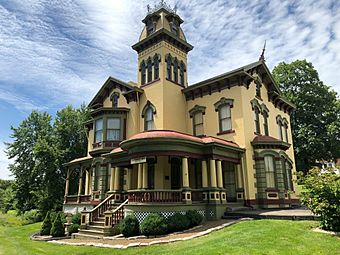Cassius Clark Thompson House facts for kids
Quick facts for kids |
|
|
Cassius Clark Thompson House
|
|
|
U.S. Historic district
Contributing property |
|

Front of the house
|
|
| Location | 305 Walnut St., East Liverpool, Ohio |
|---|---|
| Area | Less than 1 acre (0.40 ha) |
| Built | 1876 |
| Architectural style | Late Victorian, Italianate |
| Part of | East Liverpool Downtown Historic District (ID83001985) |
| NRHP reference No. | 71000637 |
| Added to NRHP | September 28, 1971 |
The Cassius Clark Thompson House is a special old home in East Liverpool, Ohio, United States. It was built in 1876. This house shows off a cool style called Italianate, which was popular during the Victorian era. It was once the home of a very important businessman in East Liverpool.
Contents
Meet Cassius Clark Thompson
Cassius Clark Thompson was born in 1851. He became a big name in East Liverpool's main industry: pottery. He owned a very successful pottery company that started in 1868.
Thompson wanted to build a grand house for himself. He bought a piece of land on a hillside. This spot had an amazing view of the nearby Ohio River.
Designing a Unique Home
The house he built is made of brick. It also has parts made of wood and stone. The building is two-and-a-half stories tall.
The most eye-catching part of the house is a tall tower at the front. This tower is three stories high. It has a fancy wrought iron railing at the top.
A Place in History: National Register
In 1971, the Thompson House was added to the National Register of Historic Places. This is a list of important historical sites in the United States. It was only the second property in Columbiana County to get this special honor.
The house earned its spot on the list for two main reasons. First, its architecture is very important historically. Second, it was home to one of the area's most famous people.
Part of a Bigger Picture
Many other buildings in East Liverpool have also joined the National Register. The East Liverpool Downtown Historic District was added in 2001. This district includes over one hundred important buildings, like the Thompson House.



